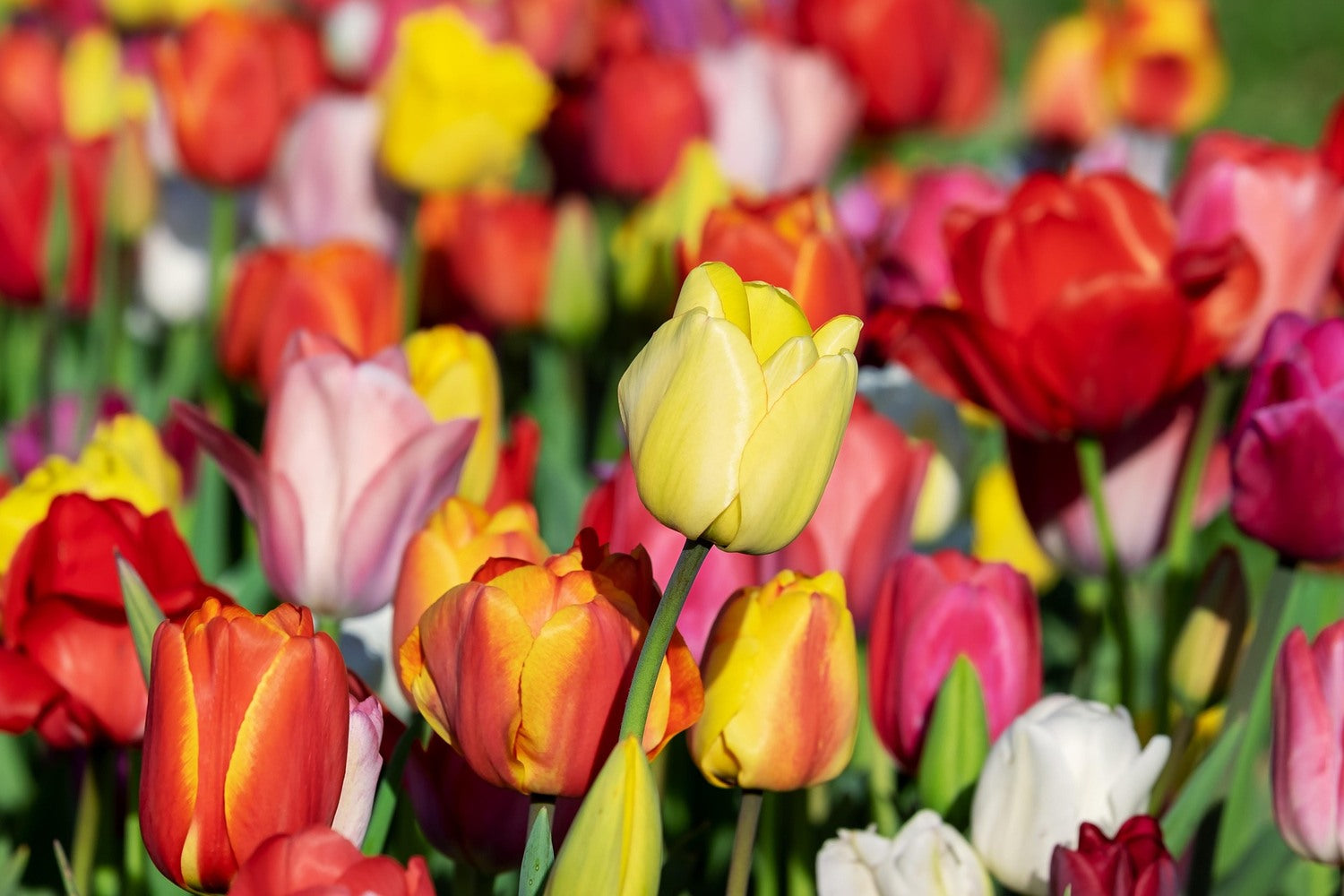Many gardeners plant tulip bulbs expecting blooms, only to watch in disappointment as their carefully tended garden produces weak, stunted flowers. Our tulips are harvested to be ready for everything – from planting to blooming. Learn the difference between pre-chilled vs. regular tulips for optimal flowering results.
Pre-Chilled vs. Regular Tulips General Overview
To kick off our discussion, let's establish a foundational understanding of what distinguishes pre-chilled tulips from their regular counterparts.

Overview of Pre-Chilled Tulips
Pre-chilled tulips are tulip bulbs that have undergone a period of artificial cooling, mimicking the cold winter dormancy they naturally require. This pre-treatment enables them to bloom successfully in warmer climates or when planted later in the season.
Overview of Regular Tulips
Regular tulips are standard tulip bulbs that have not undergone any artificial chilling process and require a natural cold period to initiate flowering. They are best suited for climates with sufficiently cold winters and external factors such as dormancy for proper growth and blooming.
Comparing Regular and Pre-Chilled Tulips
Delving deeper into the characteristics of each type reveals both shared traits and significant divergences that influence their suitability for various gardening scenarios.
Similarities
Despite their differences in preparation, pre-cooled and regular tulips share several fundamental characteristics that make them both quintessential spring bulbs.
1. Basic Needs
Both pre-cooled and standard tulips require well-draining soil and a sunny location to thrive, as soggy conditions can lead to bulb rot. They also benefit from consistent moisture during their active growth period, from sprouting through flowering.
2. Bloom Appearance
Once in bloom, the aesthetic qualities of tulips are virtually indistinguishable, exhibiting the same diverse range of colors, shapes, and sizes characteristic of the tulip species. Both types produce the iconic cup-shaped flowers that are so admired in spring gardens.
3. Pest and Disease Susceptibility
Pre-cooled and regular tulip bulbs are susceptible to similar pests, such as aphids and rodents, and diseases like tulip fire. This means they also require identical preventive measures and treatments.
4. Appeal to Pollinators
Both types of tulips, once they open, offer nectar and pollen that attract early spring pollinators like bees. Their lively colors serve as a visual cue to these beneficial insects.

Differences
The most significant distinctions between pre-cooled and regular tulips lie in their growth requirements, planting flexibility, and cost.
1. Bloom Time and Flowering Patterns
Just like planting pre-chilled daffodil bulbs, pre-chilled bulbs tend to bloom earlier and more uniformly, as their chilling requirement has already been met, leading to a more predictable display. Meanwhile, regular bulbs rely on natural chilling, resulting in bloom times that can vary significantly depending on the severity and duration of the local winter climate.
2. Climate Suitability and Planting Timing
Pre-cooled tulips are ideal for warmer climates where natural chilling periods are insufficient, allowing gardeners to enjoy tulips where they otherwise couldn't. In contrast, regular tulips are best suited for regions with distinct cold winters, where they can be planted in the fall to undergo their natural dormancy.
3. Storage and Chilling Time
Pre-chilled bulbs are ready to plant upon purchase, as their chilling process is complete. Regular tulip bulbs require careful storage in a cool, dry place and then need a specific duration of cold exposure, either naturally in the ground or artificially, before they can flower.
4. Cost, Convenience, and Flexibility
While pre-cooled tulips generally cost more due to the additional labor and energy involved in their artificial chilling process, they offer greater convenience for immediate planting. Regular ones are typically less expensive, although they demand more planning and a longer chilling period for successful blooms.
Major Distinguishing Factor
The most significant distinguishing factor between pre-chilled and regular tulips is their pre-planting preparation, where pre-cooled bulbs have already undergone the necessary cold treatment. This pre-treatment removes the need for natural winter chilling, making it suitable for planting in warmer climates.
Here's how you can also distinguish them:
|
Factor |
Pre-Cooled Tulip Bulbs |
Regular Tulip Bulbs |
|
Blooming |
Bloom reliably in any climate |
Need cold winters to bloom |
|
Planting time |
Plant anytime (fall to early spring) |
Must plant in the fall only |
|
Preparation |
Ready to plant immediately |
Need 12-16 weeks in refrigerator (warm climates) |
|
Cost and convenience |
More expensive yet more convenient |
Cheaper, yet requires more work |
When to Use Pre-Chilled Tulips
Pre-chilled tulips are the perfect solution for gardeners looking for specific planting advantages, particularly in areas where natural conditions aren't ideal for traditional tulip growth.
- When you live in a region with mild winters that don't provide enough natural chilling hours for regular tulips.
- If you missed the optimal fall planting window for regular tulips, yet still desire spring blooms.
- To grow tulips indoors in pots for an early spring display, as the chilling has already been completed.

When to Use Regular Tulips
Regular tulips are the classic choice for gardeners who can leverage their local climate's natural conditions and prefer a more traditional gardening approach.
- When residing in an area with reliably cold winters that provide the necessary chilling period naturally.
- If you're planting a large number of tulips and want to minimize the total costs.
- For gardeners aiming for tulips to return and multiply year after year in suitable climates.
Which Type of Tulip for Planting Is Better?
Pre-chilled tulips are ideal for convenience and extending tulip cultivation to warmer regions. Meanwhile, regular tulips are perfect for traditional gardeners in colder climates who prioritize cost-effectiveness and natural processes. However, the better tulip is the one that best fits your unique gardening circumstances and helps you achieve your desired spring display.
Related Questions
What Are the Different Types of Tulips?
Tulips come in numerous varieties, including Darwin hybrids, triumph tulips, and parrot tulips, each offering unique colors, shapes, and blooming characteristics. These varieties range from early spring bloomers to late-season flowers.
Do Tulips Need to Be Pre-Cooled?
Tulips require a cold period of 12-16 weeks at temperatures between 35-50 degrees Fahrenheit to bloom properly, which occurs naturally in cold winter climates. In warm climates (zones 8-10), use pre-cooled bulbs or artificially chill regular bulbs before planting.
What Are the Best Practices for Planting Tulips?
Plant tulip bulbs in fall when soil temperatures consistently stay below 60 degrees Fahrenheit, placing them pointed-end up at a depth three times their height in well-draining soil with full to partial sun exposure. Water thoroughly after planting, then allow natural rainfall to provide moisture through winter.
Final Verdict
Once you know when to use regular or pre-cooled tulips, you can make better planting choices tailored to your unique gardening conditions. Transform your garden into a breathtaking tulip paradise by investing in premium tulip bulbs that deliver reliable, spectacular blooms season after season.


